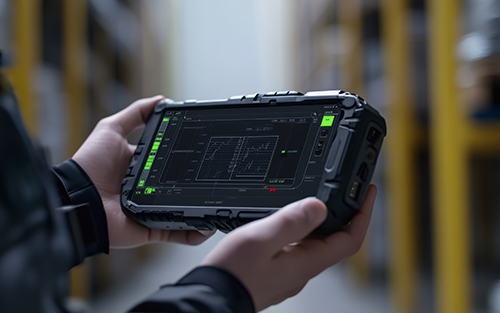- By Bhanu Handa
- October 06, 2025
- Feature
Summary
It is time to move beyond retrofitting consumer tech and embrace rugged solutions as a core part of your digital strategy.

Digital transformation has changed how organizations operate. From logistics hubs to executive offices, technology now drives decisions and daily workflows. Yet one critical area often gets overlooked, the environments where standard devices simply do not hold up. Rugged computing, once limited to military and industrial use, has quietly become essential across industries. It is no longer a specialty. It is a strategic priority.
Rethinking the device landscape
In today’s mobile and distributed workplaces, choosing the right hardware is more than a technical decision. It is about aligning the device with the demands of the job. Not every laptop or tablet is built for every environment. Some roles require technology that can thrive in tough conditions like dusty construction sites, freezing tarmacs, or high-vibration factory floors. When devices fail in these settings, the consequences go beyond inconvenience. Productivity drops, safety risks increase and costs rise.
Devices generally fall into three categories. Consumer devices are designed for personal use. They are lightweight, stylish and great for entertainment or basic tasks. But they prioritize looks and affordability over durability, making them a poor fit for demanding environments. Commercial devices are built for enterprise needs. They offer better security, manageability and support, and they form the backbone of corporate IT. Still, they are not engineered to handle physical stress or exposure to the elements.
Rugged commercial devices are built differently. They are designed from the ground up to perform in extreme conditions. These systems are tested for ingress protection, military-grade durability, and thermal resilience.
And they have evolved. Today’s rugged notebooks and tablets are sleek, secure and fully manageable. They match commercial devices in performance but far exceed them in durability.
Who is using rugged devices and why
Rugged computing has become the foundation of mission-critical operations across a wide range of industries. In manufacturing, rugged tablets and laptops are used for shop floor data entry and diagnostics. Logistics companies rely on them for fleet tracking and warehouse scanning. Construction teams use them for site inspections and accessing blueprints. Public safety agencies depend on them for field reporting and emergency response. Utilities and natural resource firms deploy rugged systems for remote monitoring and GIS mapping. Telecom technicians use them for tower maintenance in high-altitude or weather-exposed areas.
New use cases are emerging as well. Retail and fast food chains use rugged tablets for drive-thru orders, curbside pickup, and outdoor inventory. Formula 1 pit crews and professional bull riders rely on rugged devices for telemetry and real-time strategy. Car rental companies equip field agents with rugged tablets for vehicle check-in and damage documentation. Airlines use rugged systems for tarmac operations and maintenance workflows where uptime is critical.
These examples show that rugged computing is not just for niche sectors. It is a strategic enabler for organizations operating at the edge, whether that is geographic, environmental or operational.
The cost of using the wrong devices
Some organizations still try to make consumer-grade devices work in rugged settings, often by adding protective cases. But that approach does not solve the problem. These devices are not built to handle extreme temperatures, vibration, moisture or repeated drops. The result is frequent failures, costly downtime and rising support expenses.
From a leadership perspective, this is not just a technical issue. It is a strategic one. When devices fail in the field, operations stall, safety risks increase, and IT teams scramble to recover. According to Dell’s Mobile Device TCO Analysis from January 2025, the total cost of ownership for consumer devices in rugged scenarios can quietly exceed five thousand dollars per unit when you factor in replacements, lost productivity, and support overhead. These devices also lack enterprise-grade security and manageability, leaving organizations vulnerable and unable to enforce consistent IT policies.
The takeaway is clear. Use the right tool for the job. Rugged computing is not about overengineering. It is about ensuring performance where failure is not an option.
Why commercial devices still fall short
Even enterprise-grade commercial devices struggle in rugged environments. They are not designed to withstand shock, vibration, moisture, or extreme temperatures. That leads to higher failure rates and recurring downtime. Repairs often require depot servicing, which delays recovery and disrupts operations.
The hidden costs add up quickly. Lost productivity, increased IT support and frequent replacements drive up the total cost of ownership. Unlike rugged devices, commercial systems lack field serviceability and environmental certifications, making them a poor fit for frontline roles.
Durability is not a luxury. It is a requirement. Deploying commercial devices in rugged scenarios misaligns technology with task. Leaders who prioritize fit-for-purpose hardware reduce risk and unlock long-term value through reliability, uptime, and workforce confidence.
Rugged devices have evolved
One of the biggest myths about rugged computing is that it is bulky and outdated. That is no longer true. Today’s rugged devices combine durability with sleek design, portability and enterprise-grade features.
Modern rugged notebooks and tablets run on Windows and Android, with form factors that rival commercial devices in weight and aesthetics. They support TPM, secure boot, remote management and integrate seamlessly with enterprise IT systems.
The rugged ecosystem has matured too. Accessories like active pens, modular batteries, vehicle docks and shoulder straps enhance usability across diverse workflows, from inspections to diagnostics. Organizations no longer have to choose between resilience and user experience. Rugged devices deliver both.
For IT decision-makers, this evolution is a game-changer. Rugged computing is not a compromise. It is a strategic upgrade for teams that need reliability without sacrificing performance or design.
Every organization has rugged use cases
Here is a truth many overlook. Almost every organization has rugged use cases. They just have not identified them yet. If your workforce includes field personnel, mobile agents or employees who move between desk and field, there is a strong case for rugged devices.
Think about car rental companies managing outdoor check-ins and inspections. Airlines with ground crews working in extreme weather. Environmental agencies collecting data in remote terrain. Retailers running outdoor point-of-sale systems. These are not edge cases. They are everyday realities. And they demand hardware that is built to perform.
Organizations that proactively identify these use cases and invest in rugged solutions will gain a competitive edge in continuity, efficiency, and transformation. Those that do not risk falling behind, not because they lack innovation, but because they are using the wrong tools.
Rugged is not a feature; it is a strategy
Rugged computing is not just a box to check. It is a strategic enabler of productivity, safety and operational continuity. As businesses expand into mobile, remote and high-risk environments, the need for purpose-built rugged devices becomes clear. It is time to move beyond retrofitting consumer tech and embrace rugged solutions as a core part of your digital strategy.
About The Author
 Bhanu Handa is a product management leader at Dell Technologies, specializing in rugged computing solutions for industrial and defense environments. With a track record of launching and scaling rugged notebooks, tablets, accessories and software, Bhanu focuses on enabling frontline teams through purpose-built technology. His work centers on improving operational uptime, reducing total cost of ownership, and driving digital transformation in high-impact sectors.
Bhanu Handa is a product management leader at Dell Technologies, specializing in rugged computing solutions for industrial and defense environments. With a track record of launching and scaling rugged notebooks, tablets, accessories and software, Bhanu focuses on enabling frontline teams through purpose-built technology. His work centers on improving operational uptime, reducing total cost of ownership, and driving digital transformation in high-impact sectors.
Did you enjoy this great article?
Check out our free e-newsletters to read more great articles..
Subscribe

